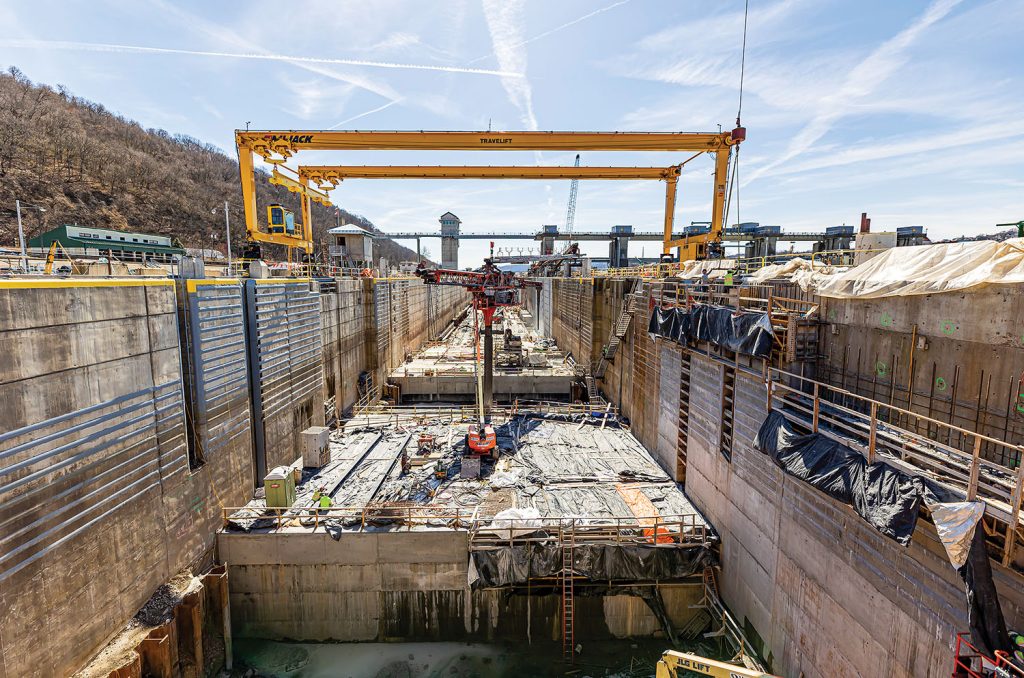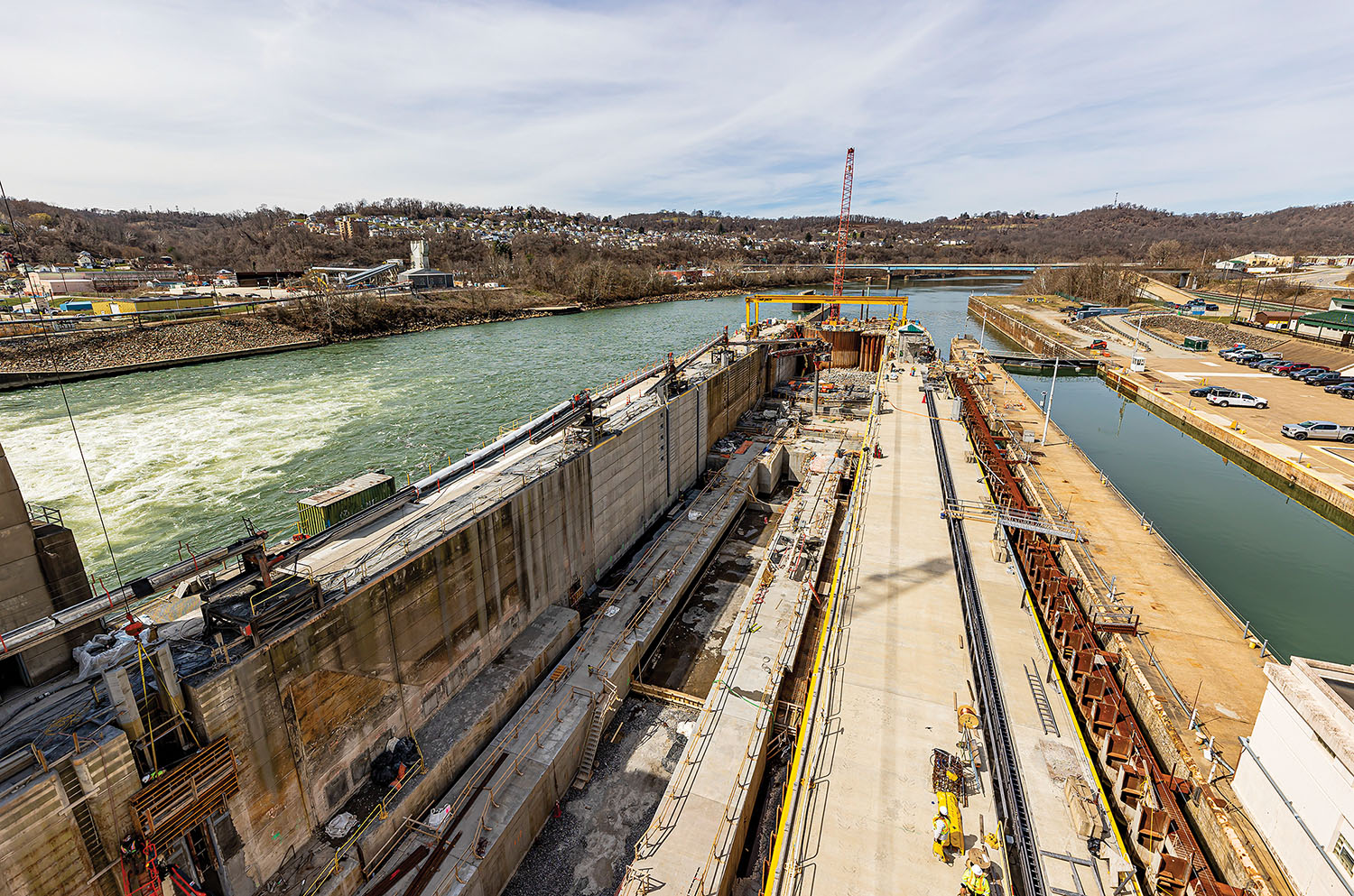A new, expanded riverside lock chamber at Charleroi, Pa., on the Monongahela River will begin filling with water sometime the week of May 22.
“That will be a big milestone for the district and the project,” said Stephen Frost, who is overseeing the project for the Pittsburgh Engineer District. “I think we’re all looking forward to that.”
The project at Locks and Dam 4, at Monongahela Mile 41.5, is part of the Lower Mon Project, sometimes referred to as a “mega project” because of its size and scope. About 84 percent of the work on the project is now complete, at a $1.2 billion cost, Frost said. It began with the installation of a new gated dam at Braddock (Locks and Dam 2), replacing the former fixed-crest dam, before work shifted to Charleroi.

Once the new lock chamber at Charleroi is flooded, testing will take place on all the lock mechanisms, with the lock expected to open to commercial traffic in early 2024.
Once the work at Charleroi is completed, crews will turn their focus to Elizabeth, Pa., at Locks and Dam 3, which will be removed to create a navigable pass and one, 30.3-mile pool instead of separate 12.3- and 18-mile pools. Full removal of the dam and locks there is estimated to take about three construction seasons, Frost said.
One Usable Lock
The work at Charleroi is now 95 percent complete to the “90 percent economic benefits” level, Frost said.
That level allows the completion of the riverside lock chamber, which is now 720 feet long and 84 feet wide. Previously it was 360 feet long and 84 feet wide, meaning it took three hours and multiple cuts for a tow to lock through. Once completed, a typical commercial tow should be able to lock through in about 40 minutes, Frost said.
The 90 percent benefits level does not include refurbishment of the landside lock at Charleroi, however. Once the dam at Elizabeth is breached, Charleroi’s landside lock chamber will be unusable for navigation. While its future refurbishment still remains authorized by the Corps, the plan signed by the assistant secretary of the Army in 2014 defers work on the landside chamber until the 2050s.
In addition to the enlargement of the riverside lock chamber, work at Charleroi has included extending the Charleroi dam stilling basin, inland river dredging and some public shoreline facility relocations.
While not without controversy from some in the industry, Frost said the decision to move forward with only one lock chamber at this time is based on a Corps economic analysis of the project that showed that the new riverside lock chamber at Charleroi, when combined with the elimination of the lock at Elizabeth, would capture “90 percent of the economic benefit” of the original scope of the Lower Mon Project, which included two locks at Charleroi. That amounts to $200 million in benefits for commercial navigation.
“We’re estimating cost-savings that come directly from the time-savings our commercial traffic will be experiencing,” Frost said.
Finishing The Lower Mon Project
The Pittsburgh Engineer District has worked closely with the Great Lakes and Rivers Division on budgeting issues to finish up the Lower Mon Project, Frost said. The last funding was included in the president’s 2020 fiscal year budget, and Congress eventually appropriated $111 million to the project.
A change in funding allocations in the 2022 Water Resources Development Act was a benefit, he said. Previously, the project was funded 50 percent by the Inland Waterways Trust Fund, generated by diesel taxes on the navigation industry, and 50 percent from general funds. WRDA 2022 authorized a 65 percent federal/35 percent trust fund split.
The project has faced challenges, however, including a host of supply chain and workforce issues that followed with the COVID-19 pandemic along with cost inflation and price adjustments.
Trumbull Corporation and Brayman were awarded the River Chamber Completion Contract at Charleroi as a joint business venture. When the lock chamber was emptied in 2021, it was full of sediment and debris, Frost said. Before work could begin, it had to be cleaned out.
The work also included completion of mass concrete, including for culverts that run parallel to and underneath the lock chamber that are used to fill it.
“That’s been pretty much the main focus for the last two years, getting that filling system installed,” Frost said. “There are culverts that pretty much go the whole length of the river chamber.”
The expanded riverside lock chamber will fit nine standard-sized barges in a single cut, Frost said.
“Tows won’t have to be broken up on the lower Mon portion of the river,” he said. “They should be able to sail straight through without double-locking anywhere.”
Upper Ohio Project Next
Although the Lower Mon Project is nearing completion, Frost said that doesn’t mean other massive projects aren’t still on the horizon.
“Once we have the Lower Mon Project completed, we’re not resting on those laurels,” Frost said. “We have another inland navigation project brewing on the Ohio River, first of all at Montgomery and then Emsworth and Dashields as well.”
Work at those locks and dams is part of the Upper Ohio Project, another mega project, and ground has already been broken at Montgomery Locks and Dam. Andrew Byrne, public affairs specialist for the Pittsburgh Engineer District, said the $3.6 million contract for the work at Montgomery Locks and Dam was awarded to AAECON General Contracting LLC on May 5. The contract involves preparation work, such as building the construction field office and upgrading site utilities, before the subsequent construction contract for the new river chamber is awarded.
“The preparation work is expected to begin within the next several months,” he said.
Caption for top photo: Construction laborers perform work on the chamber floor concrete infill and wall-facing rebar and formwork for the Charleroi Lock Construction Project at the Monongahela River Locks and Dam 4 in Charleroi, Pa., in March of this year. The newly constructed chamber is scheduled to be filled with water beginning later this month. (Pittsburgh Engineer District photo by Michel Sauret)




